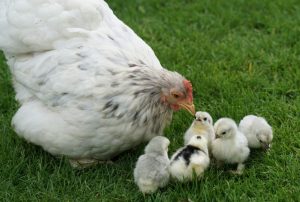Overview
The first records of the Cochin Chicken in the UK date back to the 1830’s / 40’s, when early imports were presented to Queen Victoria this breed was known as Shanghai’s.
The Chinese Shanghai fowl came to America in 1845 and was first admitted to the American Poultry Association (APA) in 1874.
The name of this Asiatic breed was later changed to Cochin. The earliest Cochins were more or less buff in color. Its striking appearance, due to great size and profuse soft feathering, distinguished it from all other known breeds at the time.
Cochins created a sensation in England, resulting in a great boom for the ‘Cochin China’, as it was called in the days of the ‘Cochin craze’.
This breed massively contributed to the rise in popularity in keeping chickens and having them as backyard pets.
Males weigh between 7.9-13lbs (3.6-5.9kgs) and females weigh between 7-11lbs (3.2-5kgs).
Eggs
Size
Medium size eggs
Color
Brown or tinted
Production per year
120 eggs per annum
When do they start laying eggs?
From 20 weeks
Cochin Characteristics
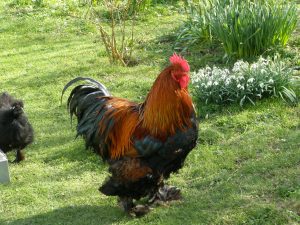
Temperament / Are they good as pets?
They’re friendly and would make really good backyard pets.
How do I tame Cochin hens?
Taming chickens is best done when they’re younger, pick them up and hold them to get them used to human contact. If you’ve got older chickens you want to tame, feed them from your hand.
How many do I need to buy?
2 chickens is the smallest number you should buy, but its best to have a small flock of at least 6.
How much space do they need?
This breed is remarkably lazy and don’t need lots of land to roam as they prefer confinement.
Will they mix with my other chickens?
Yes they should mix, they’re non-aggressive so shouldn’t cause any problems.

Cochin Chickens Appearance
These are impressively large birds and are rather round in appearance due to being heavier than most breeds.
They are distinctive due to their excessive plumage which covers all of their body, even their feet!
The cochin chicken recognized variety with recognized colors in the UK and America are: black, cuckoo, barred, grouse, blue, partridge, silver-laced, buff, brown, gold-laced and white.
They have a single comb and yellow skin.
A Black Cochin has standard black plumage. Shank and outer toe feather are black aswell.
A Blue Cochin Chicken has blue shank and outer toes! They are very difficult to breed and two blue cochins wont breed offspring with a true blue color! A blue cochin is shown in the photo below:
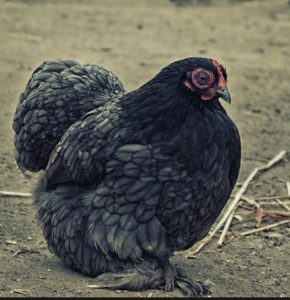
Bantam Cochin Chickens
Bantam version exist of the large Cochin chicken. These bantams in the UK are largely referred to as Pekins. The bantams have the same great characteristics as the large version. They are so so friendly, and will give great cuddles! Plus they are great mothers, and will nurture and look after chicks amazingly well.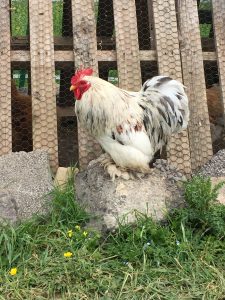
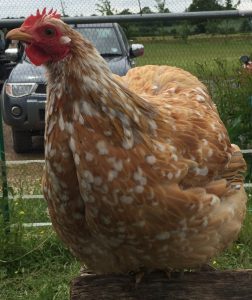
Image above: these are our gorgeous Cochin Bantams
Being smaller than the standard (large) Cochin they will eat less and typically consume 2oz of feed per day. They aren’t the best foragers so wont supplement much more within their diet from this.
A bantam female will weigh 26oz whereas a bantam cockerel will weigh 30oz.
Caring for Cochin Chickens during Summer
With all those feathers and fluff its hardly surprising they aren’t a hot weather bird. With the following suggestions i’ve found our Cochins are much better equipt for hot weather and so should yours with this advice.
Access to the floor
Ill start with the females are they are more stressed by heat than the males. So I make sure the females have access to the ground. I have fairly sandy soil, in the coop especially, where its repeatably walked over and loosen by the birds on a day to day basis. This is great as the Cochins like to dig down and cool of in the soil.
If you have a grass in the run/pen/coop then make sure its cut short. Having short grass will reduce the bugs and mites in the grass that can get onto the feathered part of the toes, and cause irritation.
Shade
Most of the time they will remain in the barn where its cooler and shaded, but have free rein to go where they like to suit them. Sometimes the barn and the coop can get very stuffy if its humid too. In extreme heat fans could be provided to cooler the area and birds down. Make sure they have shade, somewhere within their vicinity. Out of direct sunlight in the shade and with a cool breeze with access to the floor they will cool off happily.
Water
Access to fresh cold drinking water changed several times a day if required in extreme heat, obviously point but one that cant be repeated enough. Having a male running round will also compumd the stresss in the heat if he is chasing after the hens etc. Remove the male if this causing heat stress to the females.
Food
I reduce the corn i feed them as my feed being on a farm is quite corn heavy. I supplement with garden greens and veggies. Mine love cucumbers, and go crazy for tomatoes. These are lighter than corn and contain alot of water so aid the cooling process.
General Care
Cochins build up alot of manure on the feather near the vent. This, in hot weather will draw flies and then maggots. This can happen in a sometimes just a day. Good ventilation will help reduce flies etc.
What to look out for – females that stand awkwardly and droop their tails.
What to do – wash this area by hand and everything will be fine.
Males
You can as previously discussed remove the males, i do this so they aren’t showing off and using up energy and getting hot themselves and chasing the females round upsetting them in the heat. Males that don’t have access to the floor and cant access the soil to cool off seem to do ok. Other than that feed and water the same as you would the females.
Feeding
What should I feed them?
Until they are 6 weeks old your chicks should be fed growers mash. Growers mash is a refined version of chicken feed with 19{cfcd481556a8b43fba6af451761032bd323e94372a0c1e607} protein and has all the good thing in it that your chicks need to grow up healthy.
After 6 weeks you can give them chicken pellets which is just chicken feed in pelletized form which has 15-16{cfcd481556a8b43fba6af451761032bd323e94372a0c1e607} protein.
At 18 weeks you can slowly change their food to layers mash or layers pellets, which has around 16{cfcd481556a8b43fba6af451761032bd323e94372a0c1e607} protein. This has all the nutrients they need to help them with chicken production.
How much should I feed them?
Chickens can have between 2.9oz (80g) to 4.9oz (120g) a day. Try feeding your chickens ¼ of a pound (113g) of feed at first and then adjust based on their consumption.
It’s likely that they’ll eat more than this considering they are one of the bigger breeds. You can feed them either during meal times or just leave feed for them to eat whenever they want.
What can’t they eat?
There are lots of things that chickens shouldn’t eat, the two most important being chocolate and beans.
Chocolate has theobromine in it and beans contain phytohemagglutinin, both of these things can cause serious health problems in chickens and can lead to death.
Food that has gone moldy also shouldn’t be fed to chickens as it has bad bacteria that can make them unwell. For this reason in the UK feeding chickens leftovers is considered illegal.
What do I need to keep chickens?
Chicken’s need a coop which should have 1.1m2 or 11 square feet per chicken. Their run needs to be at least 25 square feet per chicken and it needs to be sheltered as when the ground gets wet it can matt their feathers and cause mud to get stuck under their feet.
The vegetation in their run should only be short grass as anything longer will ruin get caught in the feathers on their legs. The coop should have a perch for each of the chickens to stand on whilst they sleep and should have wooden laying boxes.
The coop needs to have a sunken fence all the way around the coop and over the top so that when you shut your chickens in at night they are safe from any predators.
Your chickens need a water container that can’t be knocked or stood in to, place it away from sunlight as chickens don’t like warm water.
Grit should also be accessible at all times so make sure you have some close to hand.
Breed Tips
- Primarily bred for exhibition, the Cochin is capable of being a meat type fowl.
- Fairly hardy in cold climates – so suitable if you live in a cold area.
- Hens lay for most of the winter
- The cochin hens will brood readily and make great mothers, even making great foster mothers for other breeds.
- Good in confinement and don’t really roam – so great if you have small backyard space.
- Can stop laying eggs after only 3 years.
